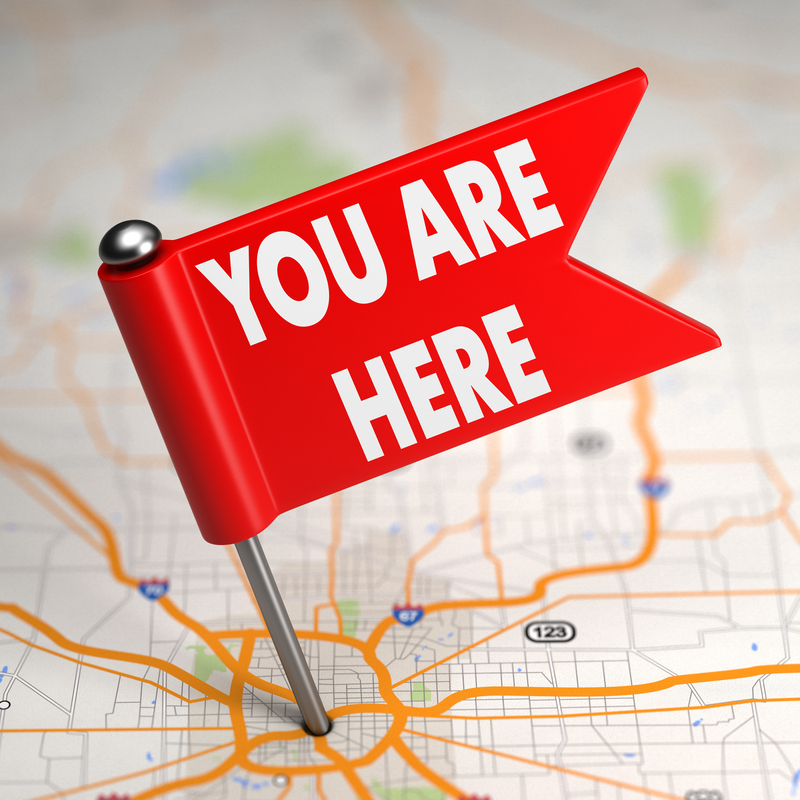The Money Map: Identifying Your Financial Starting Point

If you’ve ever attempted to follow a map to a given destination while unaware of your exact location, you know how frustrating and fruitless of an endeavor this can be.
Whether as a tourist, road-tripper, or mall-shopper, most of us have found ourselves in this situation at least once before. We all know the uncomfortable feeling of uncertainty that ensues – the second-guessing, the traveling in circles, the lost time and frustration.
It’s no mere accident that standard navigation software such as Google Maps, Apple Maps, and MapQuest require users to either input a starting location or enable the automatic tracking of their current location prior to providing directions to the selected destination.
As any road-trip veteran can attest, arriving at your planned destination requires not only identifying your starting point, but also continually monitoring your current location in the name of catching the next turn and evaluating alternate routes around unexpected obstacles.
A Tale of Two Tourists
By way of illustration, compare and contrast the scenarios of two tourists on foot in a strange city, starting from the same location and sharing a common destination. The only difference between the two is their level of preparedness and knowledge: Tourist #1 knows only his intended destination, while Tourist #2 knows both his destination and his starting point.
Tourist #1 hadn’t fully prepared for the trip and therefore his map did not indicate his current location. After a cursory review of his map he sets out in search of his destination, left to rely solely on his own educated guesses and conflicting advice from strangers in regard to his route. With no way to monitor his progress or the lack thereof, uncertainty follows his every turn. He has no way of knowing whether he’s even traveling in the right direction, much less how much further he has yet to go. After traveling in circles for hours he gives up the hunt, exhausted, frustrated, and bitter.
Tourist #2 starts from the same location as did Tourist #1, but had prepared a map in advance which illustrated both his destination and his current location. He is therefore confident in his route and is able to confirm his progress with each turn. Because he knew the length of the journey before starting out, he planned rests at appropriate intervals and had packed water and energy-providing snacks. He arrives at his destination exactly when planned, fresh, confident, and able to enjoy not only the destination, but also the journey.
Parallels to Personal Finance
Cool story. But what exactly do maps and tourists have to do with financial freedom?
Being cognizant of one’s starting point and current position is as equally important in the world of personal finance as it is in that of travel. When charting the course to your financial future, it’s not enough to merely set your destination in the form of a financial goal. Achieving that goal requires that you both identify your financial starting point and monitor your relative position in relation to said goal.
Doing so enables you to plan an optimal route to your destination, calculate the distance of your journey, plan for contingencies, identify specific areas of focus, and accurately evaluate the merits and demerits of potential shortcuts from your Point A to your Point B.
Consider a scenario in which someone resolves to build a small savings cushion after finally becoming sick and tired of the stress of living paycheck-to-paycheck. Without a clear understanding of their financial starting point in the form of their weekly income and expenses or the specific actions required to make this goal a reality, this individual is no better off than a lost tourist wandering the streets of a strange city.
Rubber, Meet Road
Hopefully by now I’ve convinced you of the impact that both setting intentional financial goals and understanding your financial starting point can have on making financial freedom a reality in your life.
Goal-setting is easy enough after some soul-searching and heart-to-hearts with your significant other. But understanding your current financial position, while equally important, will take a bit more effort. Locating your personal “You Are Here” symbol on the financial map involves three primary steps:
- Compiling a summary of all bank account, credit card, loan, and investment account balances and interest rates, along with any other assets such as homes and vehicles.
- Documenting all weekly, monthly, and annual bills, including balance due and due date information.
- Identifying your current monthly income, spending, and cash flow.
You will use this information many times over as building blocks for your personal financial game plan, carefully constructed to deliver a lifestyle of financial freedom.
Your heart probably sank as you read through the above list. You’re likely thinking that this sounds a lot like work, and dreary work at that. Make no mistake, simply collecting all of this information if you don’t already have it can be a somewhat monumental task, much less maintaining it on an ongoing basis.
Mint To The Rescue
Thankfully, there’s a dead-simple, secure, and free-to-use money management tool named Mint that can do nearly all of this heavy lifting for you once you feed it some basic info during initial setup and configuration.
Mrs. FFP and I have personally used Mint for the last seven years, and can vouch for the fact that we have yet to find a more effective tool for our financial toolbox. It has been the single most important cog in the engine that has powered us to financial freedom and independence.
For a brief explanation of how Mint works, check out this short YouTube video:
I cannot overstate just how well Mint takes the mystery and stress out of personal finance or how much power it gives you to turn the tables on and finally master your money.
Not yet convinced? You can find an in-depth review of Mint’s features, functionality, and user interface in an upcoming article. For now, focus on collecting the below information, which you’ll need in order to use Mint to nail down your “Point A” prior to embarking on your personal journey to financial freedom:
- Online banking credentials for all of your financial accounts*
- A copy of all weekly, monthly, and annual bills
Further up and further in!
*I’ve found that online banking is critical to low-stress money management. In addition, online banking is required in order to use most automated money management tools, including Mint. If you do not currently utilize online banking, read the next article to discover why it is key to starting your journey to financial freedom.



Join The Conversation!